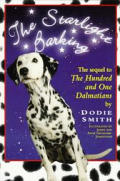
| Series: | Dalmatians #2 |
| Publisher: | St. Martin's Press |
| Copyright: | 1967 |
| Printing: | 1997 |
| ISBN: | 0-312-15664-2 |
| Format: | Trade paperback |
| Pages: | 147 |
The Starlight Barking is the almost-unknown sequel to Dodie Smith's The Hundred and One Dalmatians. It's the one that Disney never made a movie about. You don't really have to read the previous book first; it provides some context as all the previous characters show up again, but it's not required to understand what's going on.
I recently re-read The Hundred and One Dalmatians and found it rather disappointing, not living up to my memory of it. I therefore started this one with some trepidation, but it holds up quite a bit better. The plot is more interesting than a simple rescue, the 1950s sensibilities seem more moderated (possibly because there are no humans in this story), and Smith even has one of the characters comment pointedly on the whole "humans as pets" business that bothered me so much in the previous book. The Starlight Barking is still rather lightweight and doesn't do anything horribly compelling with its setup, but it was worthy of a re-read.
After a brief "where are they now" catch-up with the lives of the dalmatians and their family, the action opens with the dalmatians waking up in the country rather later than normal and with anything not canine still asleep. Anything means anything; the people and other animals are affected (except for a couple of honorary dogs), and so are insects and even the wind. All of the dogs are feeling full of energy and wonderfully well-behaved, none of them are hungry (good thing, too, since Smith's well-behaved dalmatians would never dream of biting anything, let alone killing their own food, and are rather helpless without people), they can communicate telepathically across long distances, objects move around as they need, and they shortly discover that they can fly. I was rather amused by Smith's canine wish-fulfillment environment, particularly the way that it very pointedly prevents any more realistic reversion of dogs to animals instead of pets. Clearly, the point here is a charming story about pets that raises few questions about how natural their roles are. Jim Kjelgaard this isn't.
That said, taken on its own terms, this is an effective children's story. It's definitely a children's book, not quite young adult, and therefore there isn't much in the way of plot complexity. Most of the book involves the dogs figuring out the rules of this magical day, tracking down their canine friends from the previous book, and gathering in London to decide what to do. We do, however, meet their mysterious benefactor in the end, and difficult philosophical decisions must be made. For all that you would never find this book in the SF&F section and there's no real world-building and an intentional dream-like unreality to everything that happens, this is in many ways a story of the attractions and perils of sudden advanced technology in the classic SF mode. The dogs are given a world that's completely theirs (for reasons that even fit classic SF) and have to decide how to react.
The ending is predictable for this style of book, although I won't spoil the particulars. I will say, though, that it manages a surprisingly subtle and powerful moral that gains weight on further contemplation. The choice the dogs are offered is legitimately difficult and pulls in questions of hope versus certainty, simplicity versus complexity, and even separatism versus integration (although that's a modern reading not emphasized in the text and I have no idea if the author was thinking along those lines). Smith never subverts her basic portrayal of the idyllic life of the dalmatians, but she does do the second-best thing and bring in some characters to represent the position of real pain. The resolution feels too easy to a reader used to adult stories with more catches and barbs to their offers, and initially I felt a letdown, but the more I dug at the subtext of the ending, the better I liked it.
Smith's dalmatian books hit a pet peeve of mine by presenting a very artificial and anthropomorphized view of animals. It still bothers me that she puts little of canine nature into this book beyond the most obvious and cliched. However, putting that aside, this is a surprisingly good children's book that deserves to be better known. It's much less straightforward than its better-known predecessor, probably because its setting is less grounded in simple heroics and requires more thought and attention, but I think it's a significantly better book.
Reviewed: 2006-09-24